Multi-Dimensional Evaluation of Ecosystem Health in China’s Loess Plateau Based on Function-Oriented Metrics and BFAST Algorithm
Abstract
1. Introduction
2. Materials and Methods
2.1. Study Area
2.2. Methodology
2.2.1. Data Preparation
2.2.2. Detecting Vegetation Change
- (1)
- BFAST method for short-term abrupt change
- (2)
- BFAST01 method for long-term trend
2.2.3. Establishing Indicators for Ecosystem Health
- (1)
- The number of disturbances for local dimensional evaluation
- (2)
- Recovery rate for local dimensional evaluation
- (3)
- Overall trends for overall dimensional evaluation
3. Results
3.1. Local Dimension Characteristics of Ecosystem Health
- (1)
- The number of disturbances
- (2)
- Recovery rate
3.2. Overall Dimension Characteristics of Ecosystem Health
4. Discussion
4.1. Multi-dimensional Evaluation for Ecosystem Health
4.2. The Analysis of Ecosystem Health
4.3. Limitation and Outlook
5. Conclusions
- (1)
- More than 90% of disturbance pixels of GPP and Ec in the short-term change only once and more than 60% of pixels recover after disturbance. However, the recovery rate after disturbance is slow, and the interval with the largest proportion is 0–0.00015. The long-term trend mostly exhibited a monotonic increasing trend.
- (2)
- The function of the ecosystem on the CLP has been improved, but the resilience of vegetation is weak. Overall, the health of the ecosystem has been improved, but locally, the ecosystem is not healthy.
Author Contributions
Funding
Acknowledgments
Conflicts of Interest
References
- Fang, W.; Huang, S.; Huang, Q.; Huang, G.; Wang, H.; Leng, G.; Wang, L.; Guo, Y. Probabilistic Assessment of Remote Sensing-Based Terrestrial Vegetation Vulnerability to Drought Stress of the Loess Plateau in China. Remote Sens. Environ. 2019, 232, 111290. [Google Scholar] [CrossRef]
- Feng, X.; Fu, B.; Piao, S.; Wang, S.; Ciais, P.; Zeng, Z.; Lü, Y.; Zeng, Y.; Li, Y.; Jiang, X.; et al. Revegetation in China’s Loess Plateau Is Approaching Sustainable Water Resource Limits. Nat. Clim. Change 2016, 6, 1019–1022. [Google Scholar] [CrossRef]
- He, L.; Guo, J.; Jiang, Q.; Zhang, Z.; Yu, S. How Did the Chinese Loess Plateau Turn Green from 2001 to 2020? An Explanation Using Satellite Data. CATENA 2022, 214, 106246. [Google Scholar] [CrossRef]
- Cao, S.; Chen, L.; Yu, X. Impact of China’s Grain for Green Project on the Landscape of Vulnerable Arid and Semi-Arid Agricultural Regions: A Case Study in Northern Shaanxi Province. J. Appl. Ecol. 2009, 46, 536–543. [Google Scholar] [CrossRef]
- Liu, W.; Sun, F.; Sun, S.; Guo, L.; Wang, H.; Cui, H. Multi-Scale Assessment of Eco-Hydrological Resilience to Drought in China over the Last Three Decades. Sci. Total Environ. 2019, 672, 201–211. [Google Scholar] [CrossRef] [PubMed]
- Zhang, Y.; Peng, C.; Li, W.; Tian, L.; Zhu, Q.; Chen, H.; Fang, X.; Zhang, G.; Liu, G.; Mu, X.; et al. Multiple Afforestation Programs Accelerate the Greenness in the ‘Three North’ Region of China from 1982 to 2013. Ecol. Indic. 2016, 61, 404–412. [Google Scholar] [CrossRef]
- Cao, S.; Chen, L.; Shankman, D.; Wang, C.; Wang, X.; Zhang, H. Excessive Reliance on Afforestation in China’s Arid and Semi-Arid Regions: Lessons in Ecological Restoration. Earth-Sci. Rev. 2011, 104, 240–245. [Google Scholar] [CrossRef]
- Li, J.; Peng, S.; Li, Z. Detecting and Attributing Vegetation Changes on China’s Loess Plateau. Agric. For. Meteorol. 2017, 247, 260–270. [Google Scholar] [CrossRef]
- Han, Q.; Zhang, J.; Shi, X.; Zhou, D.; Ding, Y.; Peng, S. Ecological Function-Oriented Vegetation Protection and Restoration Strategies in China’s Loess Plateau. J. Environ. Manage. 2022, 323, 116290. [Google Scholar] [CrossRef] [PubMed]
- Rapport, D.J.; Regier, H.A.; Hutchinson, T.C. Ecosystem Behavior Under Stress. Am. Nat. 1985, 125, 617–640. [Google Scholar] [CrossRef]
- He, J.; Pan, Z.; Liu, D.; Guo, X. Exploring the Regional Differences of Ecosystem Health and Its Driving Factors in China. Sci. Total Environ. 2019, 673, 553–564. [Google Scholar] [CrossRef]
- Woodcock, C.E.; Loveland, T.R.; Herold, M.; Bauer, M.E. Transitioning from Change Detection to Monitoring with Remote Sensing: A Paradigm Shift. Remote Sens. Environ. 2020, 238, 111558. [Google Scholar] [CrossRef]
- Liu, F.; Liu, H.; Xu, C.; Shi, L.; Zhu, X.; Qi, Y.; He, W. Old-growth Forests Show Low Canopy Resilience to Droughts at the Southern Edge of the Taiga. Glob. Change Biol. 2021, 27, 2392–2402. [Google Scholar] [CrossRef] [PubMed]
- von Keyserlingk, J.; de Hoop, M.; Mayor, A.G.; Dekker, S.C.; Rietkerk, M.; Foerster, S. Resilience of Vegetation to Drought: Studying the Effect of Grazing in a Mediterranean Rangeland Using Satellite Time Series. Remote Sens. Environ. 2021, 255, 112270. [Google Scholar] [CrossRef]
- Yao, Y.; Fu, B.; Liu, Y.; Li, Y.; Wang, S.; Zhan, T.; Wang, Y.; Gao, D. Evaluation of Ecosystem Resilience to Drought Based on Drought Intensity and Recovery Time. Agric. For. Meteorol. 2022, 314, 108809. [Google Scholar] [CrossRef]
- Holling, C.S. Resilience and Stability of Ecological Systems. Annu. Rev. Ecol. Evol. Syst. 1973, 4, 1–23. [Google Scholar] [CrossRef]
- Huang, Z.; Liu, X.; Yang, Q.; Meng, Y.; Zhu, L.; Zou, X. Quantifying the Spatiotemporal Characteristics of Multi-Dimensional Karst Ecosystem Stability with Landsat Time Series in Southwest China. Int. J. Appl. Earth Obs. Geoinf. 2021, 104, 102575. [Google Scholar] [CrossRef]
- Liu, M.; Liu, X.; Wu, L.; Tang, Y.; Li, Y.; Zhang, Y.; Ye, L.; Zhang, B. Establishing Forest Resilience Indicators in the Hilly Red Soil Region of Southern China from Vegetation Greenness and Landscape Metrics Using Dense Landsat Time Series. Ecol. Indic. 2021, 121, 106985. [Google Scholar] [CrossRef]
- Zhu, Z.; Woodcock, C.E. Continuous Change Detection and Classification of Land Cover Using All Available Landsat Data. Remote Sens. Environ. 2014, 144, 152–171. [Google Scholar] [CrossRef]
- Zhu, Z.; Zhang, J.; Yang, Z.; Aljaddani, A.H.; Cohen, W.B.; Qiu, S.; Zhou, C. Continuous Monitoring of Land Disturbance Based on Landsat Time Series. Remote Sens. Environ. 2020, 238, 111116. [Google Scholar] [CrossRef]
- Kennedy, R.E.; Yang, Z.; Cohen, W.B. Detecting Trends in Forest Disturbance and Recovery Using Yearly Landsat Time Series: 1. LandTrendr—Temporal Segmentation Algorithms. Remote Sens. Environ. 2010, 114, 2897–2910. [Google Scholar] [CrossRef]
- Meng, Y.; Liu, X.; Wang, Z.; Ding, C.; Zhu, L. How Can Spatial Structural Metrics Improve the Accuracy of Forest Disturbance and Recovery Detection Using Dense Landsat Time Series? Ecol. Indic. 2021, 132, 108336. [Google Scholar] [CrossRef]
- Verbesselt, J.; Hyndman, R.; Newnham, G.; Culvenor, D. Detecting Trend and Seasonal Changes in Satellite Image Time Series. Remote Sens. Environ. 2010, 114, 106–115. [Google Scholar] [CrossRef]
- Huang, C.; Goward, S.N.; Masek, J.G.; Thomas, N.; Zhu, Z.; Vogelmann, J.E. An Automated Approach for Reconstructing Recent Forest Disturbance History Using Dense Landsat Time Series Stacks. Remote Sens. Environ. 2010, 114, 183–198. [Google Scholar] [CrossRef]
- Browning, D.M.; Maynard, J.J.; Karl, J.W.; Peters, D.C. Breaks in MODIS Time Series Portend Vegetation Change: Verification Using Long-Term Data in an Arid Grassland Ecosystem. Ecol. Appl. 2017, 27, 1677–1693. [Google Scholar] [CrossRef] [PubMed]
- Watts, L.M.; Laffan, S.W. Effectiveness of the BFAST Algorithm for Detecting Vegetation Response Patterns in a Semi-Arid Region. Remote Sens. Environ. 2014, 154, 234–245. [Google Scholar] [CrossRef]
- Jong, R.; Verbesselt, J.; Schaepman, M.E.; Bruin, S. Trend Changes in Global Greening and Browning: Contribution of Short-Term Trends to Longer-Term Change. Glob. Change Biol. 2012, 18, 642–655. [Google Scholar] [CrossRef]
- Hirsch, R.M.; Slack, J.R.; Smith, R.A. Techniques of Trend Analysis for Monthly Water Quality Data. Water Resour. Res. 1982, 18, 107–121. [Google Scholar] [CrossRef]
- Hirsch, R.M.; Slack, J.R. A Nonparametric Trend Test for Seasonal Data With Serial Dependence. Water Resour. Res. 1984, 20, 727–732. [Google Scholar] [CrossRef]
- Sen, P.K. Estimates of the Regression Coefficient Based on Kendall’s Tau. J. Am. Stat. Assoc. 1968, 63, 1379–1389. [Google Scholar] [CrossRef]
- Fensholt, R.; Langanke, T.; Rasmussen, K.; Reenberg, A.; Prince, S.D.; Tucker, C.; Scholes, R.J.; Le, Q.B.; Bondeau, A.; Eastman, R.; et al. Greenness in Semi-Arid Areas across the Globe 1981–2007—an Earth Observing Satellite Based Analysis of Trends and Drivers. Remote Sens. Environ. 2012, 121, 144–158. [Google Scholar] [CrossRef]
- Pan, N.; Feng, X.; Fu, B.; Wang, S.; Ji, F.; Pan, S. Increasing Global Vegetation Browning Hidden in Overall Vegetation Greening: Insights from Time-Varying Trends. Remote Sens. Environ. 2018, 214, 59–72. [Google Scholar] [CrossRef]
- Bernardino, P.N.; De Keersmaecker, W.; Fensholt, R.; Verbesselt, J.; Somers, B.; Horion, S. Global-scale Characterization of Turning Points in Arid and Semi-arid Ecosystem Functioning. Glob. Ecol. Biogeogr. 2020, 29, 1230–1245. [Google Scholar] [CrossRef]
- Yang, Q.; Liu, X.; Huang, Z.; Guo, B.; Tian, L.; Wei, C.; Meng, Y.; Zhang, Y. Integrating Satellite-Based Passive Microwave and Optically Sensed Observations to Evaluating the Spatio-Temporal Dynamics of Vegetation Health in the Red Soil Regions of Southern China. GIScience Remote Sens. 2022, 59, 215–233. [Google Scholar] [CrossRef]
- Smith, W.K.; Dannenberg, M.P.; Yan, D.; Herrmann, S.; Barnes, M.L.; Barron-Gafford, G.A.; Biederman, J.A.; Ferrenberg, S.; Fox, A.M.; Hudson, A.; et al. Remote Sensing of Dryland Ecosystem Structure and Function: Progress, Challenges, and Opportunities. Remote Sens. Environ. 2019, 233, 111401. [Google Scholar] [CrossRef]
- Zhang, Y.; Kong, D.; Gan, R.; Chiew, F.H.S.; McVicar, T.R.; Zhang, Q.; Yang, Y. Coupled Estimation of 500 m and 8-Day Resolution Global Evapotranspiration and Gross Primary Production in 2002–2017. Remote Sens. Environ. 2019, 222, 165–182. [Google Scholar] [CrossRef]
- de Jong, R.; Verbesselt, J.; Zeileis, A.; Schaepman, M. Shifts in Global Vegetation Activity Trends. Remote Sens. 2013, 5, 1117–1133. [Google Scholar] [CrossRef]
- Brakhasi, F.; Hajeb, M.; Mielonen, T.; Matkan, A.; Verbesselt, J. Investigating Aerosol Vertical Distribution Using CALIPSO Time Series over the Middle East and North Africa (MENA), Europe, and India: A BFAST-Based Gradual and Abrupt Change Detection. Remote Sens. Environ. 2021, 264, 112619. [Google Scholar] [CrossRef]
- Li, W.; Chen, D. Changes in Gross Primary Production in Response to Afforestation in the Hilly Loess Plateau of Northern Shaanxi, China. Forests 2022, 13, 1414. [Google Scholar] [CrossRef]
- Ma, J.; Xiao, X.; Miao, R.; Li, Y.; Chen, B.; Zhang, Y.; Zhao, B. Trends and Controls of Terrestrial Gross Primary Productivity of China during 2000–2016. Environ. Res. Lett. 2019, 14, 084032. [Google Scholar] [CrossRef]
- Sun, M.; Dong, Q.; Jiao, M.; Zhao, X.; Gao, X.; Wu, P.; Wang, A. Estimation of Actual Evapotranspiration in a Semiarid Region Based on GRACE Gravity Satellite Data—A Case Study in Loess Plateau. Remote Sens. 2018, 10, 2032. [Google Scholar] [CrossRef]
- Ma, Z.; Yan, N.; Wu, B.; Stein, A.; Zhu, W.; Zeng, H. Variation in Actual Evapotranspiration Following Changes in Climate and Vegetation Cover during an Ecological Restoration Period (2000–2015) in the Loess Plateau, China. Sci. Total Environ. 2019, 689, 534–545. [Google Scholar] [CrossRef]
- Tett, P.; Gowen, R.; Painting, S.; Elliott, M.; Forster, R.; Mills, D.; Bresnan, E.; Capuzzo, E.; Fernandes, T.; Foden, J.; et al. Framework for Understanding Marine Ecosystem Health. Mar. Ecol. Prog. Ser. 2013, 494, 1–27. [Google Scholar] [CrossRef]
- Bai, M.; Mo, X.; Liu, S.; Hu, S. Contributions of Climate Change and Vegetation Greening to Evapotranspiration Trend in a Typical Hilly-Gully Basin on the Loess Plateau, China. Sci. Total Environ. 2019, 657, 325–339. [Google Scholar] [CrossRef]
- Deng, L.; Liu, G.; Shangguan, Z. Land-Use Conversion and Changing Soil Carbon Stocks in China’s ‘Grain-for-Green’ Program: A Synthesis. Glob. Change Biol. 2014, 20, 3544–3556. [Google Scholar] [CrossRef]
- Li, G.; Zhang, F.; Jing, Y.; Liu, Y.; Sun, G. Response of Evapotranspiration to Changes in Land Use and Land Cover and Climate in China during 2001-2013. Sci. Total Environ. 2017, 596-597, 256–265. [Google Scholar] [CrossRef]
- Fang, B.; Lei, H.; Zhang, Y.; Quan, Q.; Yang, D. Spatio-Temporal Patterns of Evapotranspiration Based on Upscaling Eddy Covariance Measurements in the Dryland of the North China Plain. Agric. For. Meteorol. 2020, 281, 107844. [Google Scholar] [CrossRef]
- Zhao, A.; Yu, Q.; Wang, D.; Zhang, A. Spatiotemporal Dynamics of Ecosystem Water Use Efficiency over the Chinese Loess Plateau Base on Long-Time Satellite Data. Environ. Sci. Pollut. Res. 2022, 29, 2298–2310. [Google Scholar] [CrossRef]
- Bo, Y.; Li, X.; Liu, K.; Wang, S.; Zhang, H.; Gao, X.; Zhang, X. Three Decades of Gross Primary Production (GPP) in China: Variations, Trends, Attributions, and Prediction Inferred from Multiple Datasets and Time Series Modeling. Remote Sens. 2022, 14, 2564. [Google Scholar] [CrossRef]
- Xu, S.; Yu, Z.; Yang, C.; Ji, X.; Zhang, K. Trends in Evapotranspiration and Their Responses to Climate Change and Vegetation Greening over the Upper Reaches of the Yellow River Basin. Agric. For. Meteorol. 2018, 263, 118–129. [Google Scholar] [CrossRef]
- Deng, C.; Zhang, B.; Cheng, L.; Hu, L.; Chen, F. Vegetation Dynamics and Their Effects on Surface Water-Energy Balance over the Three-North Region of China. Agric. For. Meteorol. 2019, 275, 79–90. [Google Scholar] [CrossRef]
- Zhang, K.; Kimball, J.S.; Nemani, R.R.; Running, S.W.; Hong, Y.; Gourley, J.J.; Yu, Z. Vegetation Greening and Climate Change Promote Multidecadal Rises of Global Land Evapotranspiration. Sci. Rep. 2015, 5, 15956. [Google Scholar] [CrossRef]
- He, P.; Sun, Z.; Xu, D.; Liu, H.; Yao, R.; Ma, J. Combining Gradual and Abrupt Analysis to Detect Variation of Vegetation Greenness on the Loess Areas of China. Front. Earth Sci. 2022, 16, 368–380. [Google Scholar] [CrossRef]
- Li, C.; Zhang, Y.; Shen, Y.; Kong, D.; Zhou, X. LUCC-Driven Changes in Gross Primary Production and Actual Evapotranspiration in Northern China. J. Geophys. Res. Atmos. 2020, 125. [Google Scholar] [CrossRef]
- Lu, F.; Hu, H.; Sun, W.; Zhu, J.; Liu, G.; Zhou, W.; Zhang, Q.; Shi, P.; Liu, X.; Wu, X.; et al. Effects of National Ecological Restoration Projects on Carbon Sequestration in China from 2001 to 2010. Proc. Natl. Acad. Sci. USA 2018, 115, 4039–4044. [Google Scholar] [CrossRef]
- Bryan, B.A.; Gao, L.; Ye, Y.; Sun, X.; Connor, J.D.; Crossman, N.D.; Stafford-Smith, M.; Wu, J.; He, C.; Yu, D.; et al. China’s Response to a National Land-System Sustainability Emergency. Nature 2018, 559, 193–204. [Google Scholar] [CrossRef]
- Cao, D.; Zhang, J.; Xun, L.; Yang, S.; Wang, J.; Yao, F. Spatiotemporal Variations of Global Terrestrial Vegetation Climate Potential Productivity under Climate Change. Sci. Total Environ. 2021, 770, 145320. [Google Scholar] [CrossRef]
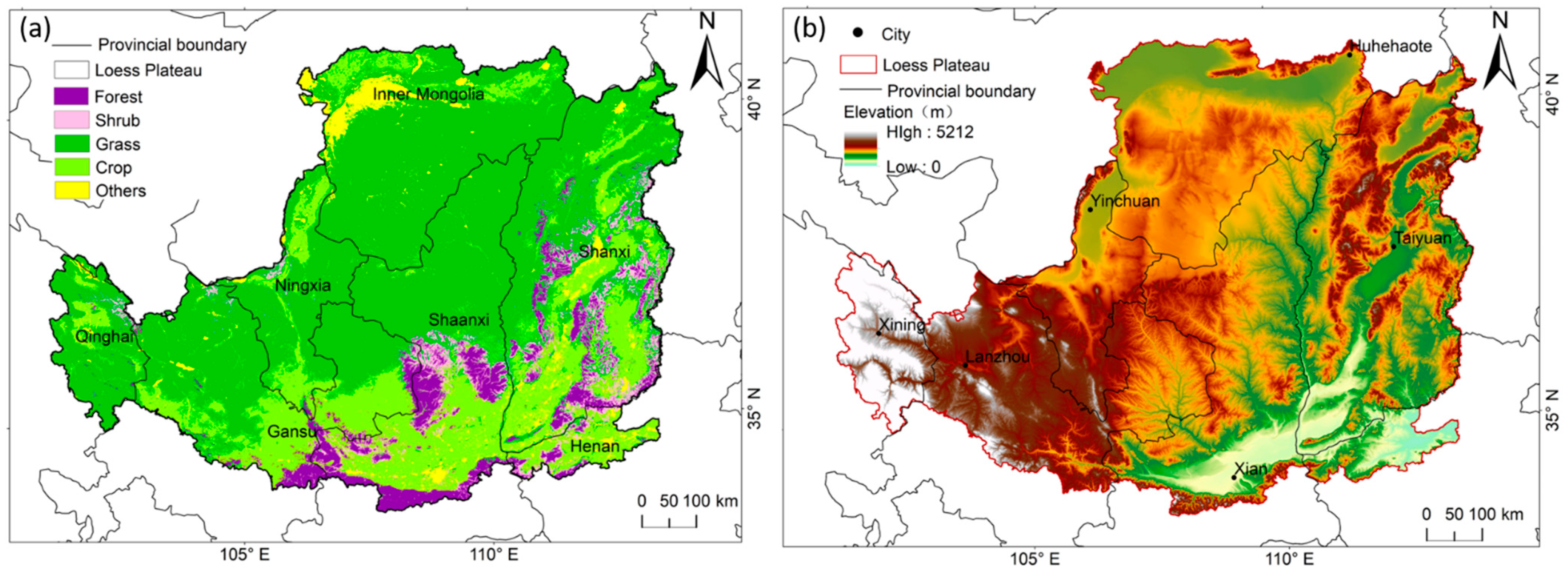
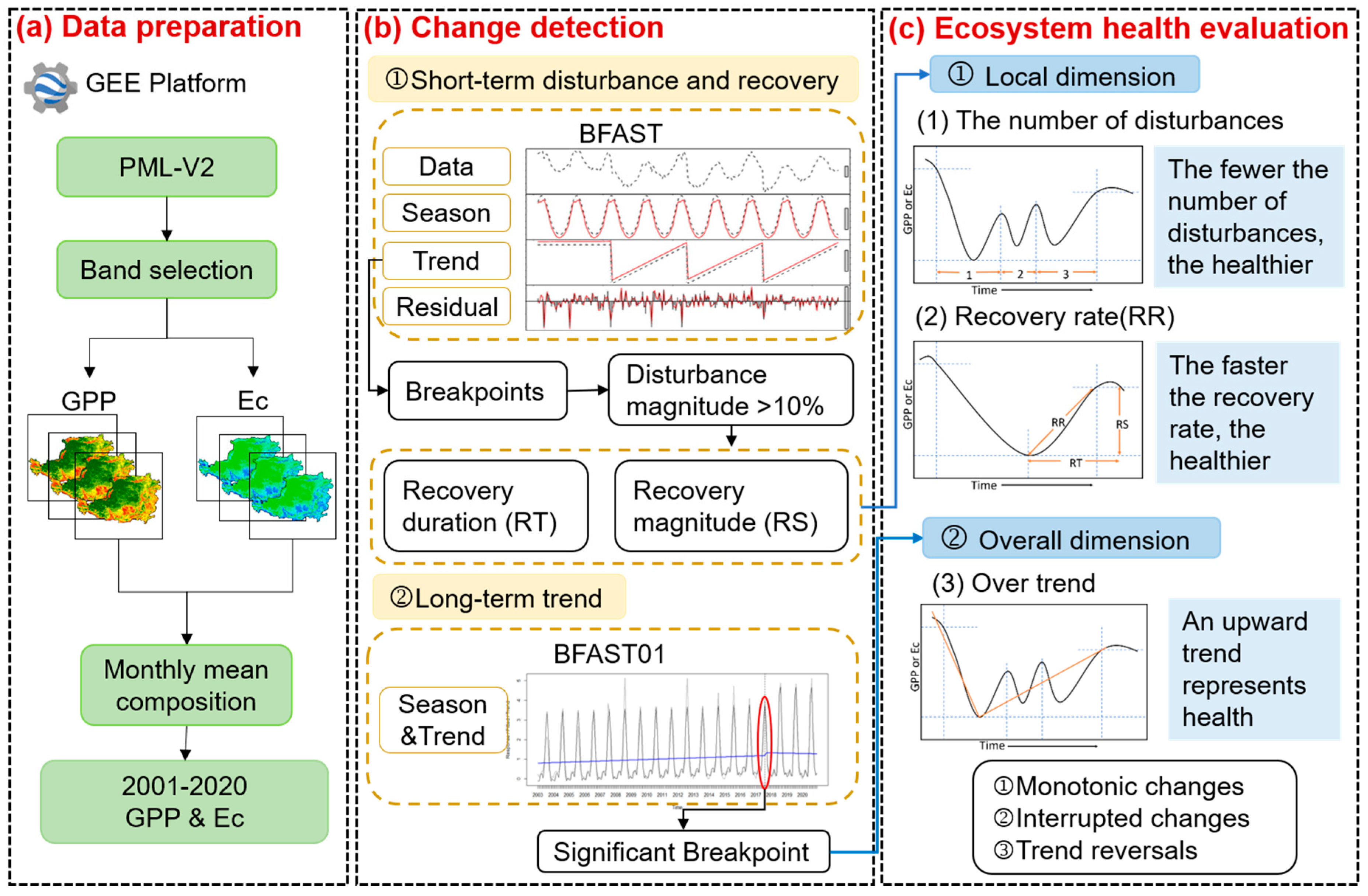
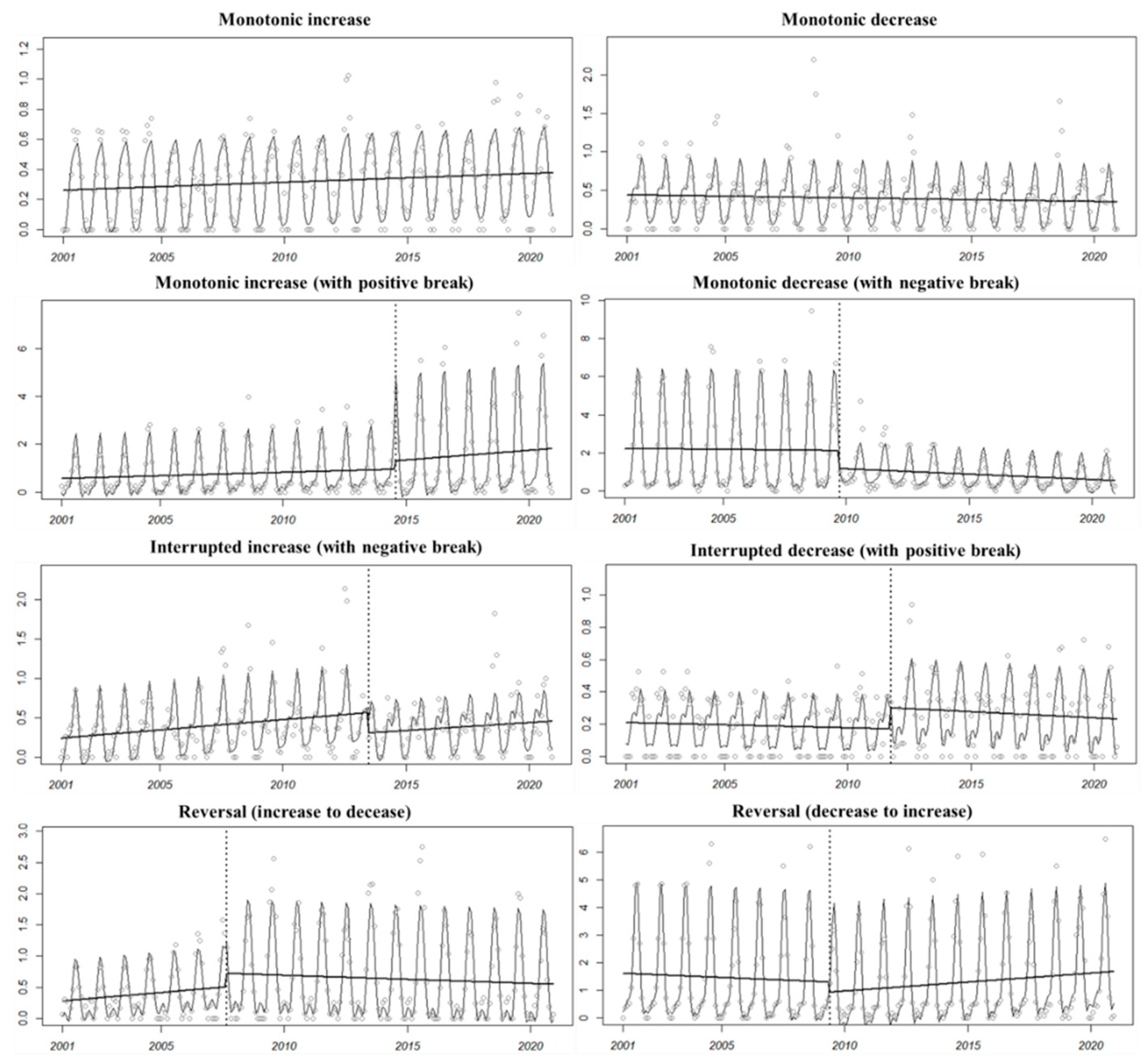



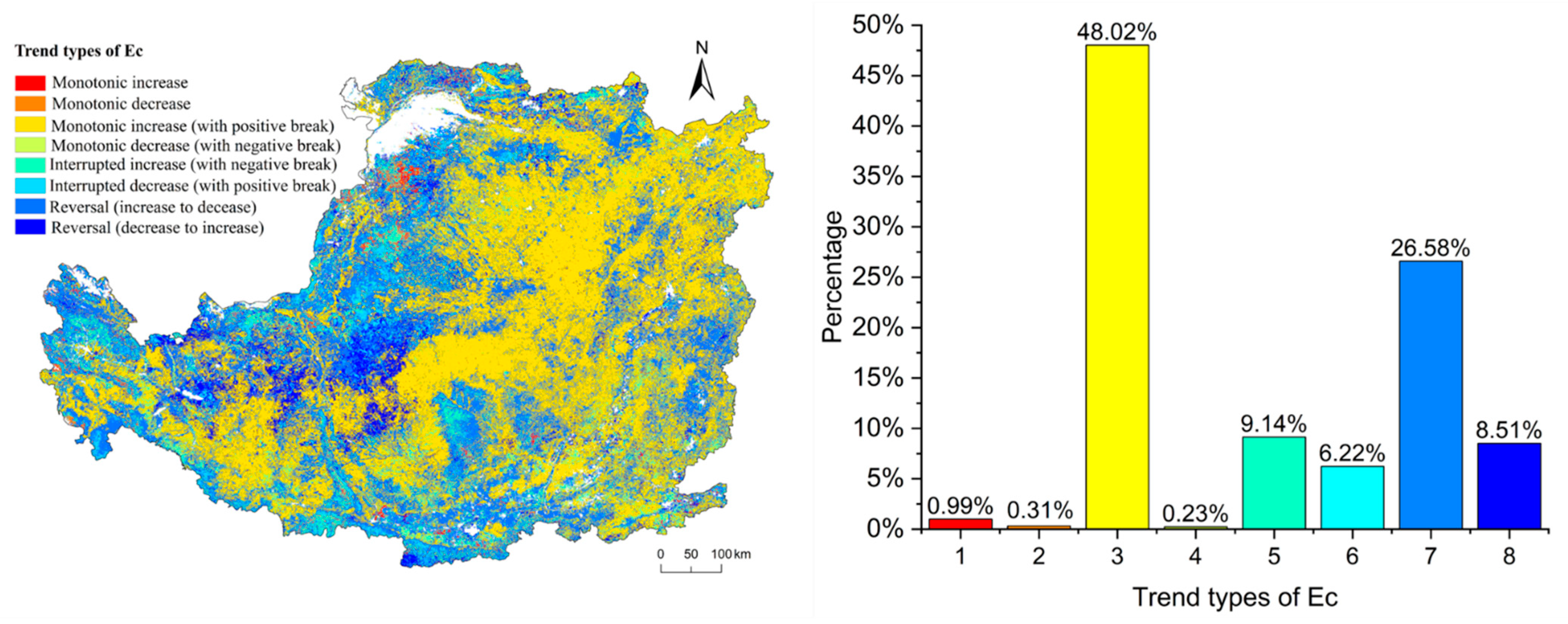
| Type of Shift | Meaning |
|---|---|
| (1) monotonic increase | No obvious mutation was detected, and the overall trend showed a monotonic increase |
| (2) monotonic decrease | No obvious mutation was detected, and the overall trend was monotonic decrease |
| (3) monotonic increase (with positive break) | 1 obvious mutation was detected, and the overall trend showed a monotonic increase |
| (4) monotonic decrease (with negative break) | 1 obvious mutation was detected, and the overall trend showed a decrease in monotonicity |
| (5) interrupted increase (with negative break) | 1 obvious mutation was detected, and the trend is that there is an obvious negative interference in the process of increase |
| (6) interrupted decrease (with positive break) | 1 obvious mutation was detected, and the trend is that there is a significant positive interference in the reduction process |
| (7) reversal: increase to decrease | 1 obvious mutation was detected, and the trend changed from increasing to decreasing |
| (8) reversal: decrease to increase | 1 obvious mutation was detected, and the trend changed from decreasing to increasing |
| Indicators to Evaluate Ecosystem Health | |||
|---|---|---|---|
| Indicators | The Number of Disturbances | Recovery Rate | Overall Trend |
| Formula of calculation | —— | —— | |
| Description | When an ecosystem cannot maintain its own state, obvious disturbance will occur. Therefore, the fewer the number of disturbances, the stronger the ability to maintain its own state and the healthier the ecosystem. | The recovery rate represents the resilience of an ecosystem after being disturbed. The faster the recovery rate, the stronger the resilience and the healthier the ecosystem. represents recovery rate, represents the recovery amplitude and represents the disturbance duration. | The upward trend of GPP and Ec can represent the enhancement of vegetation carbon sequestration capacity, the enhancement of evapotranspiration, and the health of ecosystem. |
| Graphic |  | 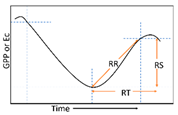 | 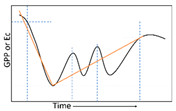 |
Disclaimer/Publisher’s Note: The statements, opinions and data contained in all publications are solely those of the individual author(s) and contributor(s) and not of MDPI and/or the editor(s). MDPI and/or the editor(s) disclaim responsibility for any injury to people or property resulting from any ideas, methods, instructions or products referred to in the content. |
© 2023 by the authors. Licensee MDPI, Basel, Switzerland. This article is an open access article distributed under the terms and conditions of the Creative Commons Attribution (CC BY) license (https://creativecommons.org/licenses/by/4.0/).
Share and Cite
Li, X.; Liu, X.; Hou, B.; Tian, L.; Yang, Q.; Zhu, L.; Meng, Y. Multi-Dimensional Evaluation of Ecosystem Health in China’s Loess Plateau Based on Function-Oriented Metrics and BFAST Algorithm. Remote Sens. 2023, 15, 383. https://doi.org/10.3390/rs15020383
Li X, Liu X, Hou B, Tian L, Yang Q, Zhu L, Meng Y. Multi-Dimensional Evaluation of Ecosystem Health in China’s Loess Plateau Based on Function-Oriented Metrics and BFAST Algorithm. Remote Sensing. 2023; 15(2):383. https://doi.org/10.3390/rs15020383
Chicago/Turabian StyleLi, Xiaoyue, Xiangnan Liu, Bowen Hou, Lingwen Tian, Qin Yang, Lihong Zhu, and Yuanyuan Meng. 2023. "Multi-Dimensional Evaluation of Ecosystem Health in China’s Loess Plateau Based on Function-Oriented Metrics and BFAST Algorithm" Remote Sensing 15, no. 2: 383. https://doi.org/10.3390/rs15020383
APA StyleLi, X., Liu, X., Hou, B., Tian, L., Yang, Q., Zhu, L., & Meng, Y. (2023). Multi-Dimensional Evaluation of Ecosystem Health in China’s Loess Plateau Based on Function-Oriented Metrics and BFAST Algorithm. Remote Sensing, 15(2), 383. https://doi.org/10.3390/rs15020383






